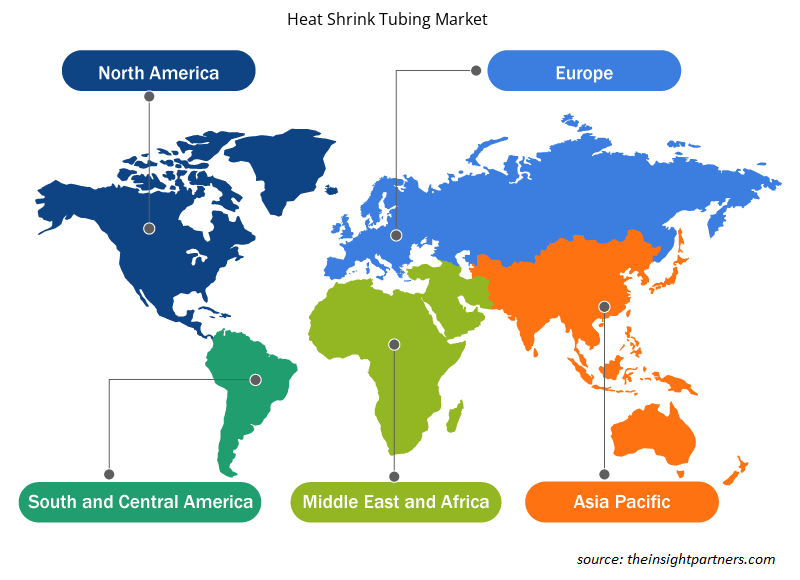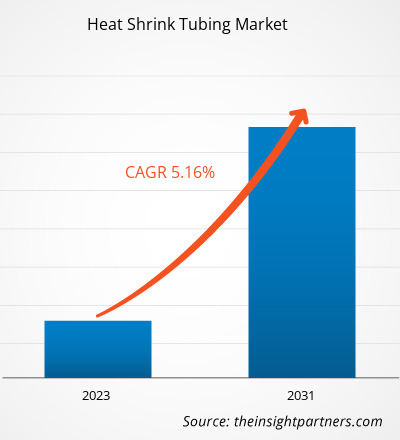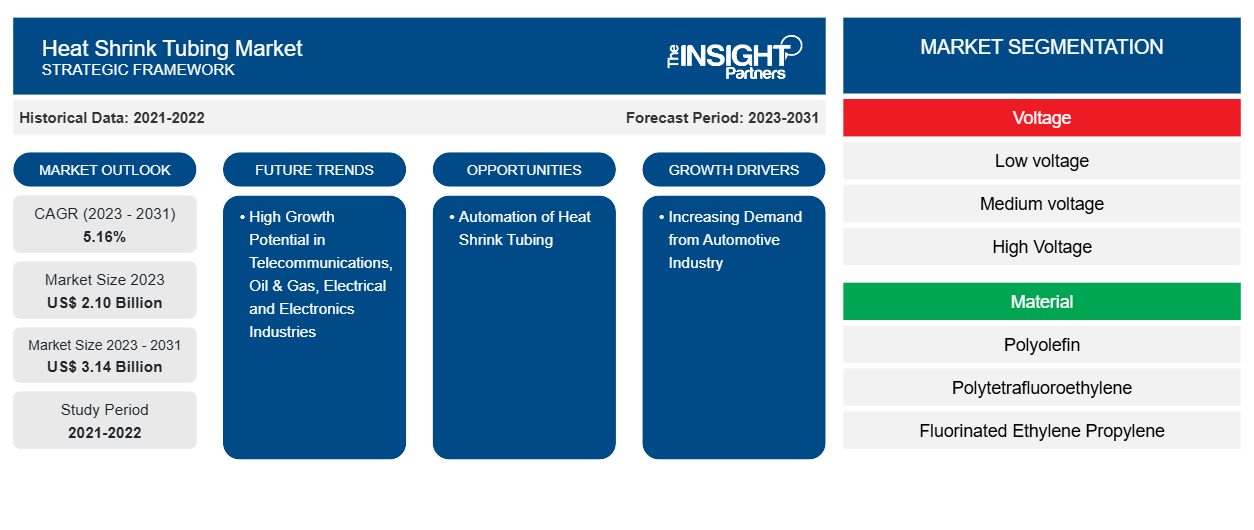Se prevé que el tamaño del mercado de tubos termorretráctiles alcance los 3.140 millones de dólares en 2031, frente a los 2.100 millones de dólares en 2023, con una CAGR del 5,16 % en 2031. La creciente demanda de la industria automotriz y las iniciativas gubernamentales para mejorar los sistemas de transmisión y ampliar la distribución se encuentran entre los principales factores que impulsan el crecimiento del mercado. Además, el alto potencial de crecimiento de industrias como la electricidad y la electrónica, las telecomunicaciones y el petróleo y el gas ofrecen oportunidades de crecimiento lucrativas para el mercado. Se espera que la automatización del proceso de tubos termorretráctiles surja como una tendencia en el mercado durante 2023-2031.
Análisis del mercado de tubos termorretráctiles
Los principales actores del ecosistema del mercado incluyen proveedores de materias primas, fabricantes de tubos termorretráctiles y clientes o usuarios finales. El proveedor de materias primas es un actor clave en el ecosistema del mercado. Los principales componentes de los tubos termorretráctiles incluyen materiales como poliolefina, politetrafluoroetileno, etileno propileno fluorado, perfluoroalcoxialcano, fluoruro de polivinilideno y otros.
Descripción general del mercado de tubos termorretráctiles
Los fabricantes de tubos termorretráctiles producen el producto según los requisitos de la industria y son compatibles con una amplia gama de aplicaciones. Las empresas de tubos termorretráctiles se centran cada vez más en mejorar la eficiencia y la autonomía de las baterías mediante la mejora de la infraestructura de carga. La presencia de un gran número de fabricantes de tubos termorretráctiles compite a gran escala principalmente en función de los materiales avanzados y la disponibilidad de presencia en todo el mundo. Entre ellos se incluyen 3M, Shenzhen Woer Heat Shrinkable Material Co., Ltd; TE Connectivity y Sumitomo Electric Industries, Ltd, entre otros actores.
Personalice este informe según sus necesidades
Obtendrá personalización en cualquier informe, sin cargo, incluidas partes de este informe o análisis a nivel de país, paquete de datos de Excel, así como también grandes ofertas y descuentos para empresas emergentes y universidades.
- Obtenga las principales tendencias clave del mercado de este informe.Esta muestra GRATUITA incluirá análisis de datos, desde tendencias del mercado hasta estimaciones y pronósticos.
Factores impulsores y oportunidades del mercado de tubos termorretráctiles
Demanda creciente de la industria automotriz
Con la creciente tendencia de los vehículos eléctricos, la creciente necesidad de aparatos con cables está impulsando el mercado. El tubo termorretráctil en un vehículo eléctrico se utiliza en muchas aplicaciones para proteger los cables desde el enchufe de carga hasta los componentes eléctricos del tablero del vehículo, el sistema de limpiaparabrisas, el sistema de iluminación, el sistema de cierre centralizado, el sistema acústico, el sistema de aire acondicionado , etc.
Alto potencial de crecimiento en las industrias de telecomunicaciones, petróleo y gas, electricidad y electrónica
Los tubos termorretráctiles tienen diversos usos y se utilizan ampliamente en cables de redes de telecomunicaciones. Los tubos termorretráctiles se utilizan para proteger estas conexiones, cables, conductores, juntas y terminales contra daños ambientales. Además, la industria del petróleo y el gas se enfrenta a los efectos y condiciones ambientales más desafiantes. El calor extremo, la corrosión, la presión y otros factores afectan el equipo utilizado en la industria del petróleo y el gas. Los tubos termorretráctiles garantizan que el equipo brinde un rendimiento constante y confiable. Por lo tanto, la demanda de tubos termorretráctiles en las industrias de telecomunicaciones, petróleo y gas, y electricidad y electrónica brinda amplias oportunidades para el crecimiento del mercado.sures the equipment delivers consistent and reliable performance. Thus, the demand for heat shrink tubing across telecommunications, oil & gas, and electrical & electronics industries provides ample opportunities for market growth.
Análisis de segmentación del informe de mercado de tubos termorretráctiles
Los segmentos clave que contribuyeron a la derivación del análisis del mercado son voltaje, material y usuario final.
- Según el voltaje, el mercado se divide en bajo voltaje (menos de 5 kV), medio voltaje (5-35 kV) y alto voltaje (más de 35 kV). El segmento de bajo voltaje (menos de 5 kV) tuvo una mayor participación de mercado en 2023.
- Según el material, el mercado mundial de tubos termorretráctiles se divide en poliolefina, politetrafluoroetileno, etileno propileno fluorado , perfluoroalcoxialcano, fluoruro de polivinilideno y otros. El segmento de poliolefina tuvo una mayor participación de mercado en 2023.
- Según el usuario final, el mercado global se divide en energía, servicios públicos, energía eléctrica, construcción de infraestructuras y edificios, industria, telecomunicaciones, automoción, aeroespacial, defensa, transporte público y movilidad, medicina, petroquímica y minería. El segmento de servicios públicos tuvo una mayor participación de mercado en 2023.
Análisis de la cuota de mercado de los tubos termorretráctiles por geografía
El alcance del informe de mercado de tubos termorretráctiles abarca América del Norte (EE. UU., Canadá y México), Europa (España, Reino Unido, Alemania, Francia, Italia y el resto de Europa), Asia Pacífico (Corea del Sur, China, India, Japón, Australia y el resto de Asia Pacífico), Oriente Medio y África (Sudáfrica, Arabia Saudita, Emiratos Árabes Unidos y el resto de Oriente Medio y África) y América del Sur y Central (Brasil, Argentina y el resto de América del Sur y Central). En términos de ingresos, APAC dominó la participación de mercado de tubos termorretráctiles en 2023. América del Norte es el segundo mayor contribuyente al mercado mundial de tubos termorretráctiles, seguida de Europa.
Perspectivas regionales del mercado de tubos termorretráctiles
Los analistas de Insight Partners explicaron en detalle las tendencias y los factores regionales que influyen en el mercado de tubos termorretráctiles durante el período de pronóstico. Esta sección también analiza los segmentos y la geografía del mercado de tubos termorretráctiles en América del Norte, Europa, Asia Pacífico, Oriente Medio y África, y América del Sur y Central.

- Obtenga datos regionales específicos para el mercado de tubos termorretráctiles
Alcance del informe de mercado de tubos termorretráctiles
| Atributo del informe | Detalles |
|---|---|
| Tamaño del mercado en 2023 | US$ 2.10 mil millones |
| Tamaño del mercado en 2031 | US$ 3,14 mil millones |
| CAGR global (2023 - 2031) | 5,16% |
| Datos históricos | 2021-2022 |
| Período de pronóstico | 2023-2031 |
| Segmentos cubiertos | Por voltaje
|
| Regiones y países cubiertos | América del norte
|
| Líderes del mercado y perfiles de empresas clave |
|
Densidad de actores del mercado de tubos termorretráctiles: comprensión de su impacto en la dinámica empresarial
El mercado de tubos termorretráctiles está creciendo rápidamente, impulsado por la creciente demanda de los usuarios finales debido a factores como la evolución de las preferencias de los consumidores, los avances tecnológicos y una mayor conciencia de los beneficios del producto. A medida que aumenta la demanda, las empresas amplían sus ofertas, innovan para satisfacer las necesidades de los consumidores y aprovechan las tendencias emergentes, lo que impulsa aún más el crecimiento del mercado.
La densidad de actores del mercado se refiere a la distribución de las empresas o firmas que operan dentro de un mercado o industria en particular. Indica cuántos competidores (actores del mercado) están presentes en un espacio de mercado determinado en relación con su tamaño o valor total de mercado.
Las principales empresas que operan en el mercado de tubos termorretráctiles son:
- Hellermann Tyton
- Industrias Sumitomo Electric, Ltd.
- SHAWCOR Molex LLC
- 3M
- Shenzhen Woer Material termorretráctil Co., Ltd.
- Material electrónico de Shanghái Changyuan Co., Ltd.
Descargo de responsabilidad : Las empresas enumeradas anteriormente no están clasificadas en ningún orden particular.

- Obtenga una descripción general de los principales actores clave del mercado de tubos termorretráctiles
Noticias y desarrollos recientes del mercado de tubos termorretráctiles
El mercado se evalúa mediante la recopilación de datos cualitativos y cuantitativos a partir de investigaciones primarias y secundarias, que incluyen publicaciones corporativas importantes, datos de asociaciones y bases de datos. A continuación, se incluye una lista de los avances en el mercado en materia de innovaciones, expansión comercial y estrategias:
- En marzo de 2024, Junkosha, especialista en materiales y pionero de los tubos termorretráctiles pelables de FEP (PHST), presentó su última innovación basada en catéteres, la solución PHST translúcida con una relación de contracción de 1,8:1, en la feria MD&M West del 6 al 8 de febrero de 2024. (Fuente: Junkosha, comunicado de prensa)
Informe de mercado de tubos termorretráctiles: cobertura y resultados
El informe “Tamaño y pronóstico del mercado de tubos termorretráctiles (2021-2031)” proporciona un análisis detallado del mercado que cubre las siguientes áreas:
- Tamaño del mercado de TUBOS TERMORETRÁCTILES Tamaño y pronóstico a nivel global, regional y nacional para todos los segmentos clave del mercado cubiertos bajo el alcance.
- Dinámica del mercado, como impulsores, restricciones y oportunidades clave
- Tendencias del mercado de TUBOS TERMORETRÁCTILES
- Análisis detallado de las cinco fuerzas de Porter y PEST y FODA
- Análisis del mercado de TUBOS TERMORETRÁCTILES que abarca las tendencias clave del mercado, el marco global y regional, los principales actores, las regulaciones y los desarrollos recientes del mercado
- TUBOS TERMORETRÁCTILES Panorama de la industria y análisis de la competencia que cubre la concentración del mercado, análisis de mapas de calor, actores destacados y desarrollos recientes.
- Perfiles detallados de empresas
- Análisis histórico (2 años), año base, pronóstico (7 años) con CAGR
- Análisis PEST y FODA
- Tamaño del mercado, valor/volumen: global, regional y nacional
- Industria y panorama competitivo
- Conjunto de datos de Excel
Informes recientes
Testimonios
Razón para comprar
- Toma de decisiones informada
- Comprensión de la dinámica del mercado
- Análisis competitivo
- Información sobre clientes
- Pronósticos del mercado
- Mitigación de riesgos
- Planificación estratégica
- Justificación de la inversión
- Identificación de mercados emergentes
- Mejora de las estrategias de marketing
- Impulso de la eficiencia operativa
- Alineación con las tendencias regulatorias





















 Obtenga una muestra gratuita para - Mercado de tubos termorretráctiles
Obtenga una muestra gratuita para - Mercado de tubos termorretráctiles